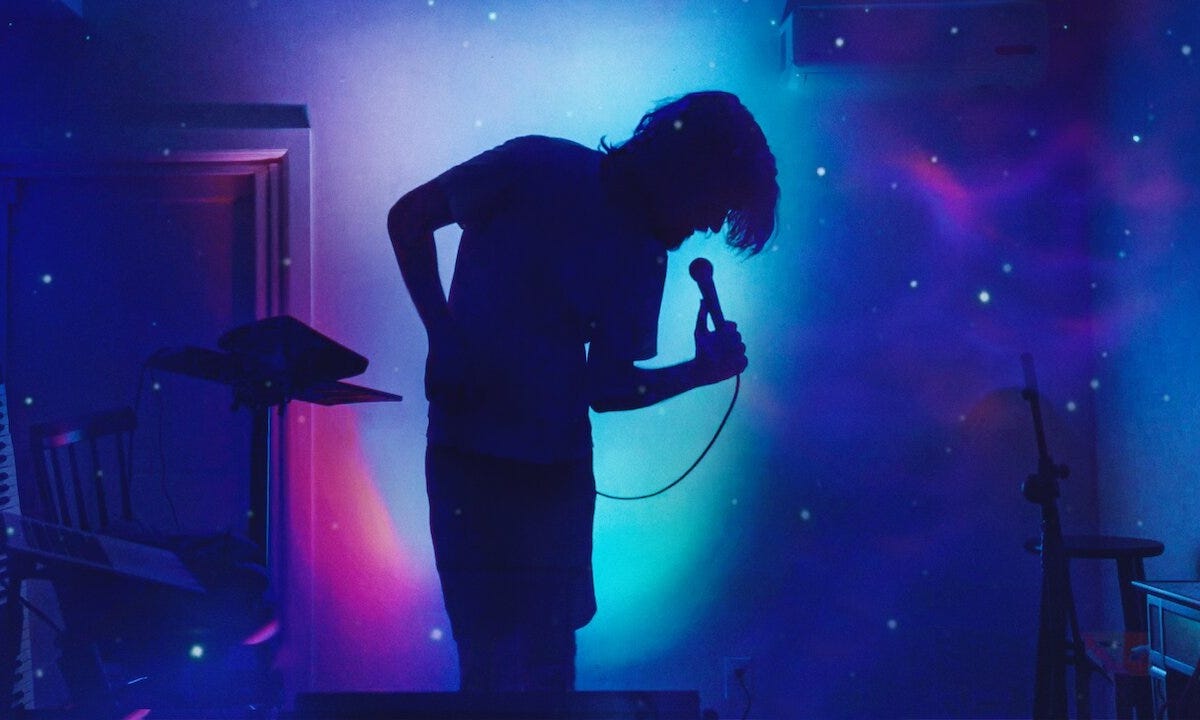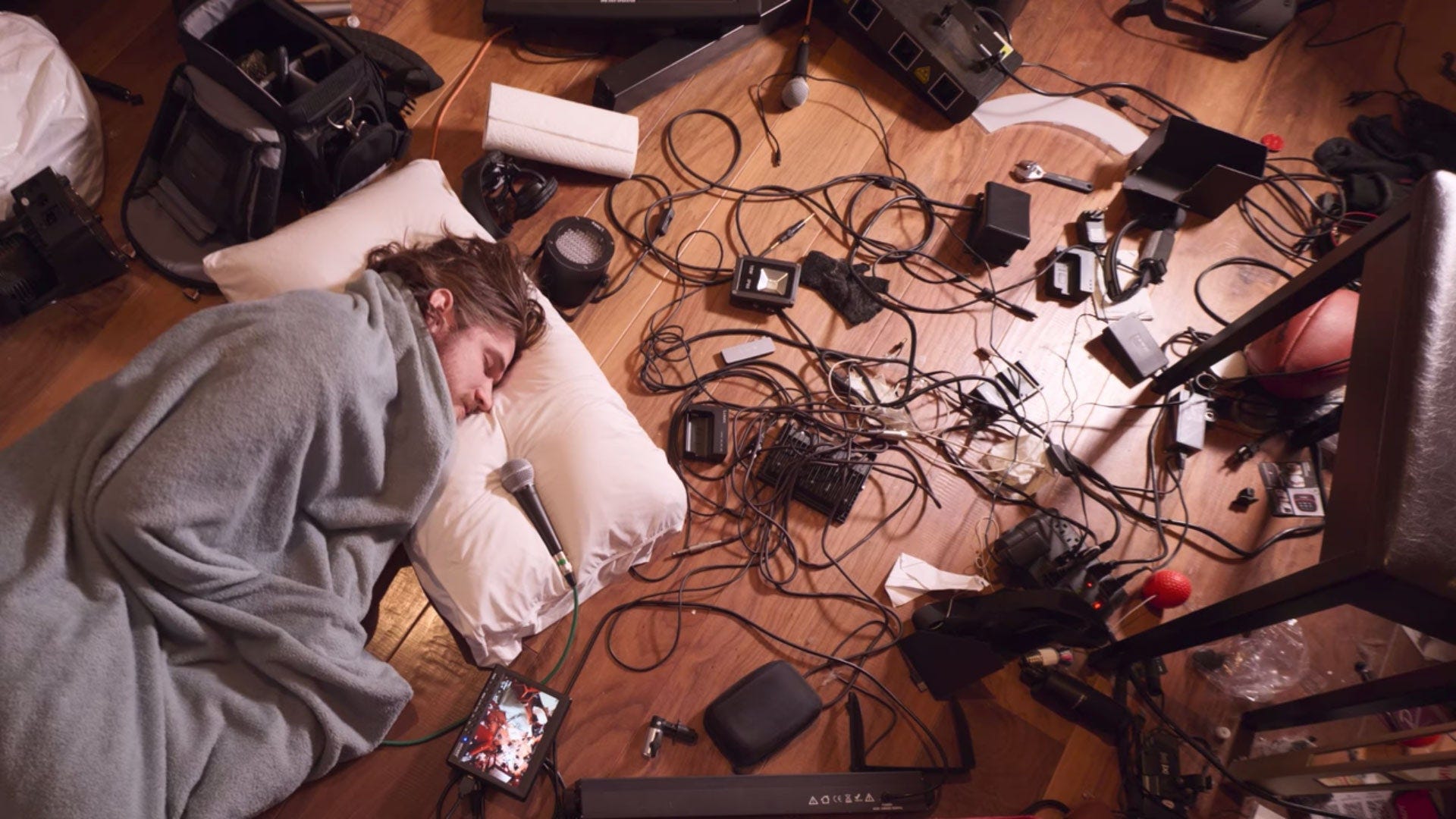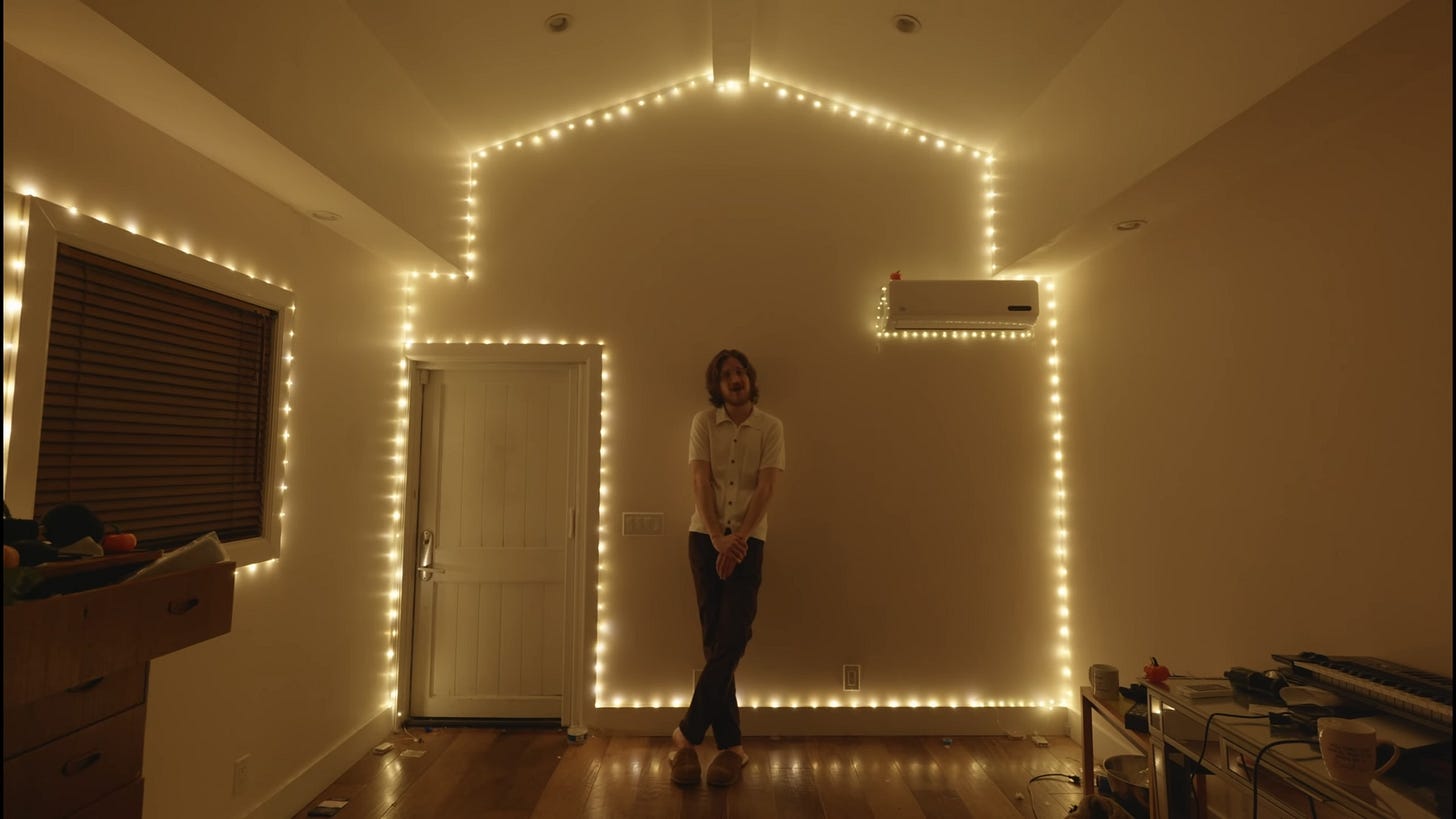Poets Watching TV: 10 Things This Poet (Re)Learned from Bo Burnham’s Inside
The genre-bending comic's Netflix special made a huge splash last year and was recently honored with a Grammy in addition to its other accolades. It's still inspiring me as a poet almost a year later.

When I first watched Bo Burnham’s Inside, I didn’t know what I was getting myself into. I had simply heard it was “good.”
But the singing stand-up comic’s 2021 Netflix special was way, way more than just good. It was, and remains, dark, honest, powerful, and virtuosic. Isolated in the guest house of his former Los Angeles home, Burnham wrote, edited, shot, directed, and performed the special over a period of more than a year during the (still ongoing, at the time of this writing) COVID-19 pandemic. The result is an 87-minute odyssey into the content-creating, anxiety-ridden, massively online, artistic millennial male mind. It’s also hilarious, even as it questions the role of comedy in an increasingly, well, shitty world.
In addition to jokes and funny little interstitial bits, the special features 20 songs that were later released as an album, Inside (The Songs). One song, the impeccable “All Eyes on Me,” recently won a Grammy and reignited my desire to write about what it’s like to watch Inside as a poet.
True, Inside isn’t a “TV show” in the purest sense, and certainly not the kind of “process television” I’ve written about before. But I’m expanding what Poets Watching TV means in order to think about the format more generally: What can we learn as writers and creatives from media that’s beamed directly into our households, media that was made to be watched on a television screen?
To me, Inside counts as a Poets Watching TV feature because that’s how it was originally released: as a Netflix special. Though it later opened in theaters on select dates in the summer of 2021, Inside is made for those of us who are, of course, staying inside: a place that has started to take on a new significance for all of us—and perhaps especially for writers, the quintessential indoor cats of the art world, in particular—during these pandemic years.
Look Who’s Inside Again
Part of what makes Inside so wonderful is that it manages to say so much about a range of topics: contemporary dating, aging, mental health, consumerism, work, social media, cultural appropriation, capitalism, and more. If you want to watch it as a meditation on just one of any of those topics, you can do so and will come away with great insights.
As an artist myself, I’m interested in how Burnham the artist made this work and what its making might mean for all of us. Not everything has to have a use value, but every time I watch Inside I’m impressed by the creative practices that Burnham engages in and the effect they have on me as a viewer. Here are ten things I (re)learned by (re)watching Inside.
10 Things This Poet (Re)Learned from Bo Burnham’s Inside
1. Write what you know: literally.
Ibsen wrote that the artist’s job was to write about the questions central to his age. Burnham certainly got that memo, as comedians often do. Humor about the state of the world as it is plays well, and when you write about what you know, you’re able to speak from the sovereignty of your own experience rather than co-opting the experiences of others.
More broadly, even if watching media peripherally “about” the pandemic gives you that “too soon” shiver, there’s power in speaking to your own moment, even if it seems scary. And if you’re interested in changing the world as it is, deciding where we are is a good place to start before forging ahead.
2. Let yourself play.
Watching Inside, you get the sense that Burnham was just trying some shit in many segments.
In a few spare moments, we even see him tweaking camera setups and lighting effects. There are some songs that involve tons of props, like “White Woman’s Instagram,” and others that involve only his voice and a keyboard, like the why-is-this-so-catchy “Bezos I.” Each song has its own flavor, and some of the weirder techniques Burnham tried—like projecting eggplant emojis onto his face—turn out to be strangely beautiful.
I think writing and writing programs, in general, don’t emphasize experimentation enough and focus instead on getting a piece “right” or imitating established (read: old, white, male) models. So I challenge you to get fully weird with your writing if you’re reading this. You never know what you might discover.
3. You don’t need any tools that you don’t already have.
In The Creative Fire, Clarissa Pinkola Estes discusses the allure of art supplies and their relationship to procrastination. If I just had a new easel, you might think, then I would start painting again. Or I don’t have the right recording equipment for the music I want to make. Or My laptop is broken. You might even balloon out the idea of supplies to space and time, which is more legitimate but no less limiting: if I could just quit my day job, do a residency, take some more classes… then I would make the art I want to make.
There are absolutely issues of privilege in play, here. Disparities in income and time availability make it easier for some to create than it does for others. Burnham is wealthy, famous, and had his girlfriend and dog 20 feet away, but he still managed to make an entertaining music video in his underwear while using a cell phone light for effect. Try telling yourself that you already have everything you need and see what happens.
And if you do have the means to get new supplies or attend a residency, make space in your life for them today. Immerse yourself in what you have in a broader sense. Then reach out and help a fellow creative increase their own means: support their Patreon, subscribe to their newsletter, buy their art, etc.
4. Constraint produces creativity (duh).
Sure, constraint on the level that Burnham experienced it, spiraling into a mental health crisis brought on by isolation and depression about the value of his art, can be a bad thing. But asking your creative mind to function within a set of predetermined limitations can create magical results.
That’s the logic behind formal poetry, minimalist theater, and even black and white photography, in its way. When you have unlimited options, sometimes creating art seems intimidating. Any subject, any length, any words… whew! But setting yourself a task within a particular box—a poem of this many lines, a poem written entirely within the space of my lunch break, a poem written only in a blue crayon I stole from my kid—can help you see things in a new way and reach conclusions faster.
5. If you can’t put your finger on it, show it instead.
One of the special’s final songs, “That Funny Feeling,” does an amazing job of living out the oft-repeated advice to show rather than tell. Burnham lists off dozens of events, products, and instances that either exist as polarized, hypermodern mundanities (“Reading Pornhub’s terms of service / going for a drive”) or darker moments that make him have that “funny feeling” that the world is fucked: “A gift shop at the gun range / a mass shooting at the mall” or, my favorite, “A book on getting better hand-delivered by a drone.”

Without overtly naming the “feeling” itself, Burnham allows us to identify it for ourselves. I referred to the feeling above as “the world is fucked,” but there are other definitions available, given the breadth of the images he offers. Showing your audience the markers of a particular feeling rather than describing the feeling itself can also help you express yourself if you’re not even quite sure what you think about something. Let the images lead you forward.
6. The try is as important as the success.
I love watching the little segment where Burnham is sitting on the floor singing then stops, harshly chastises himself for “[taking] a big fucking breath” in the middle of his song, then starts over.
It seems that Burnham’s process involves many more attempts than completions. In another segment, he sings an entire song wonderfully, then approaches the camera, muttering something to the effect of “let’s try one more.”
Revising and trying, trying again are the cornerstone of any creative practice, even self-shot music videos about sexting. It’s also worth noting that Burnham’s songs are short: he hasn’t worked out how to stretch them into three-and-a-half-minute standards, nor should he. Sometimes all he’s got is a brief funny thought, and it’s enough: Burnham’s “Shit” is 1 minute 18 seconds long and it’s hilarious.
Don’t tell yourself you have to write a magnum opus: just start with a couple of good lines.
7. Rawness is a risk worth taking.
The special reaches its emotional nadir with Burnham’s shattering admission that he’s not doing very well mentally, after which he sobs on camera. Whether it’s real or not, it’s raw and shocking, and it puts a period on the damaging nature of isolation, mental health issues, fame, and just the awfulness of modern life.
Is it hokey to film yourself crying? I don’t know. Ask TikTok. Is it cringe? Is it arrogant? I think the only thing we can agree on is that it’s risky. And risk, in art, is worth it in my estimation. Burnham’s emotional rawness paid off. It doesn’t always, and I’m not advocating for abandoning revision and precision in writing. But I do think that sometimes we’re afraid to just convey the raw thing we mean in poetry, and in other art forms. So I say, take the risk. Allow yourself moments of rawness.
Or you could just write another poem about a tree that’s outside your window and risk nothing. The choice is yours.
8. Try out a comic’s observational eye.
Sometimes even the most quotidian things can resonate with meaning when alchemized into art. Many times during Inside, Burnham’s attention is like a roving eyeball merely pointing things out to us: Facetime, latte foam art, interns. But after the flat observation comes the argument: Boomers don’t understand how to use basic technology, which makes interacting with them extremely painful; white women have a highly homogenized aesthetic on Instagram that may hide toxic behavior or genuine pain; unpaid internships should be illegal.
Not sure what to write about? Start with what’s right in front of you.
9. Get meta: Document the creative process itself.
I love reading and listening to creative types talk about their own process, and typically, Poets Watching TV posts have focused on process television for this reason.
Sometimes hearing creative folks talk about creativity is incredibly banal and a little irritating: I just let it flow, man. I don’t really know where it comes from. But other times it’s deeply insightful. Burnham doesn’t overtly discuss his process, but we can intuit clues just from watching Inside.
Burnham is inspired by persona work, stage-like lighting effects, critiques of performativity, internet culture, and DIY processes. How do you work best? What inspires you? Take your process as seriously as Burnham asks us to take his.
10. You really need to get outside.
I won’t tout the virtues of fresh air, long lunches with friends, outdoor concerts, or hiking, though they all have their benefits. Going outside and living among other people is a kind of performance, as Burnham shows us in the special’s final minutes, but the “inside” world alone can’t sustain us. The internet is an exhilarating and terrible place, but real-life interactions—the stuff of actual living—is required in order to make art.
We also need to get outside of the systems that keep us docile, doom-scrolling, and ultimately powerless. We need to make outside a better place to be for the most vulnerable among us, not just for rich white guys like Burnham, and I think he’d agree.
How the World Works
Burnham made Inside by himself, but was he really alone for a year while he made it?
No. Burnham, again, was isolated in a kind of creative play place. He was feet away from a still-isolated but much cushier existence in his home. At one point we see him making up a sad-looking little bed and getting into it in his studio space, but you’d better believe he got up and marched himself into bed in the main house with his longtime partner Lorene Scafaria after filming that segment. Or at least one would imagine.
Whether you view Inside as a genuine document of a mental health crisis or as a highly curated performance piece about the disintegration of modern life, you’ve watched the special correctly. Both interpretations add value, and the act of art interpretation is more important than the interpretation itself.
My only worry is whether or not Inside perpetuates, whether on purpose or by accident, the notion that creating great art requires suffering. The past few years have introduced so many of us to more suffering than ever before, and I hope we’re able to examine that pain through art. But in the end, I mostly just hope we’re able to take better care of each other, ourselves, and the world outside our door.





